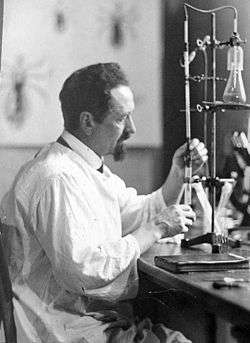Rudolf Weigl
| Rudolf Stefan Weigl | |
|---|---|
|
Rudolf Weigl in his laboratory | |
| Born |
2 September 1883 Prerau, Austria-Hungary |
| Died |
11 August 1957 (aged 73) Zakopane, Poland |
| Nationality | Polish |
| Occupation | Research biologist |
Rudolf Stefan Weigl (2 September 1883 – 11 August 1957, Zakopane, Poland) was a Polish biologist and inventor of the first effective vaccine against epidemic typhus. He founded the Weigl Institute in Lwów, Poland (now Lviv, Ukraine), where he conducted vaccine research.[1]
There, during the Holocaust, he harbored Jews, thereby risking execution by the Germans. His vaccines were also smuggled into the Lwów Ghetto and the Warsaw Ghetto, saving countless additional Jewish lives.[2]
Life
Weigl was an Austrian of German ethnicity, born in Prerau (now Přerov), Moravia, when it was part of the Austrian part of the Austro-Hungarian Empire. When he was a child, his father died in a bicycle accident. His mother, Elisabeth Kroesel, married a Polish secondary-school teacher, Józef Trojnar, and they raised Weigl in Jasło, Poland.
Later the family moved to Lviv (Lwów in Polish, Lemberg in German), where in 1907 Weigl graduated from the biology department at the University of Jan Kazimierz, where he had been a pupil of Professors Benedykt Dybowski (1833–1930) and J. Nusbaum–Hilarowicz (1859–1917). After graduation, Weigl became Nusbaum's assistant and in 1913 completed his habilitacja in the department of comparative zoology and anatomy.[1]
During the Nazi German occupation of Poland in World War II, Weigl's research attracted the attention of the Nazis. When they occupied Lviv, they ordered him to set up a vaccine production plant at his Institute. About a thousand people worked there. Weigl employed and protected Polish intellectuals, Jews and members of the Polish underground. His vaccines were smuggled into ghettos in Lviv and Warsaw, saving countless lives, until the Institute was shut down by the Soviet Union following their 1944 anti-German offensive.[3]
In 1945 Weigl moved to Kraków, Poland. He was appointed Chair of the General Microbiology Institute of Jagiellonian University, and later Chair of Biology of the Poznań Medical Faculty. Production of the vaccine remained at Kraków for some years until discontinued.
Weigl died on 11 August 1957 in the Polish mountain resort of Zakopane.[1]
The Weigl Institute features prominently in Andrzej Żuławski's 1971 film, The Third Part of the Night.
In 2003, a half-century after his death, Professor Weigl was recognized by Israel as a Righteous among the Nations of the World.[4][5]
Vaccine

In 1930, following Charles Nicolle's 1909 discovery that lice were the vector of epidemic typhus, and following the work done on a vaccine for the closely related Rocky Mountain Spotted Fever, Weigl took the next step and developed a technique to produce a typhus vaccine by growing infected lice and crushing them into a vaccine paste. He refined this technique over the years until 1933, when he performed large-scale testing. The method comprised four major steps:
- Growing healthy lice, for about 12 days;
- Injecting them with typhus;
- Growing them more, for 5 additional days;
- Extracting the lice's midguts and grinding them into a paste (which was the vaccine).
Growing lice meant feeding them blood, the more human the better. At first he tested his method on Guinea pigs, but around 1933 he began large-scale testing on humans, feeding the lice human blood by letting them suck human legs through a screen. This could cause typhus during the latter phase, when the lice were infected. He alleviated this problem by vaccinating the human "injectees", which successfully protected them from death (though some did develop the disease).[6] Weigl himself developed the disease, but recovered.
The first major application of his vaccine was conducted between 1936 and 1943 by Belgian missionaries in China. The vaccine was dangerous to produce and hard to make on a large scale. Over time, other vaccines were developed that were less dangerous and more economical to produce, including the Cox vaccine developed on egg yolk.
See also
- Feeder of lice
- List of Poles
- Ludwik Fleck
- Ludwik Hirszfeld, microbiologist, Holocaust survivor
Notes
- 1 2 3 Waclaw Szybalski, "The genius of Rudolf Stefan Weigl (1883 – 1957), a Lvovian microbe hunter and breeder" In memoriam. McArdle Laboratory for Cancer Research, University of Wisconsin, Madison WI 53705, USA
- ↑ T Tansey (2014) Typhus and tyranny, Nature 511(7509), 291.
- ↑ Halina Szymanska Ogrodzinska, "Her Story". Recollections
- ↑ Rudolf Weigl at Yad Vashem website
- ↑ Znak Magazine, Righteous from Wroclaw at the Wayback Machine (archived March 25, 2007) 24.07.2003.
- ↑ Weigl, at www.lwow.home.pl
Bibliography
- Arthur Allen, The Fantastic Laboratory of Dr. Weigl: How Two Brave Scientists Battled Typhus and Sabotaged the Nazis, Norton, 2014, ISBN 978-0393081015.
External links
- Biography of Weigl (1967) by Stefan Kryński
- Page with many Weigl links and pictures
- Overview of the experiment--Maintenance of human-fed live lice in the laboratory and production of Weigl's exanthematous typhus vaccine (1999) by Wacław Szybalski
- Ann. Acad. Med. Gedan., 1974, 4, 19-51 by Stefan Krynski, Eugeniusz Becla, and Marian Machel
- Bibliography of typhus and Weigl history articles from PubMed
- Nominations for the Nobel Prize between 1930-1939
- News article about receipt of "Righteous Among the Nations of the World" medal for helping Jews during World War II
- Recollections of Halina Szymanska Ogrodzinska, reporting the underground activities of the Weigl Institute
- Pictures of the Weigl Institute and a little history
- How Charles Nicolle of the Pasteur Institute discovered that epidemic typhus is transmitted by lice: reminiscences from my years at the Pasteur Institute in Paris by Ludwik Gross, August 6, 1996
- Scientists Created A Typhus Vaccine In A 'Fantastic Laboratory'. Fresh Air, NPR books author interviews, July 22, 2014.


